On Saturday last, my chum James invited me over to an afternoon of ACW gaming and a delicious dinner of pulled pork courtesy of his lovely wife, Elizabeth. A very pleasant day. We revisited the brigades we had fought with in our previous game. All figures are 28mm from my own collection.
James had two regiments of Seasoned Veteran infantry (4 and 6 stands strength), a regiment of Eager Recruits (5 stands) from his first fight, and a new regiment of Seasoned Veterans (6 stands) that he had gained between battles. He also had 6 stands of Eager Recruit cavalry and two light (6pdr) cannon (he had lost a light howitzer in our previous fight). You can read his account of the battle here, but I assure you that my account is more truthful.
My command, under Archibald Eustace Glossop, a renowned cavalry commander from the Mexican War, had two regiments of Eager Veteran infantry: the 21st Mississippi (6 stands), the 9th Texas (5 stands), and one of Eager Recruit infantry (14th Mississippi, 7 stands), I also had 7 bases of Eager Recruit cavalry (the 9th Kentucky). I was well set with artillery. Besides my three bases of light artillery from my first battle (2 cannon and 1 howitzer), I had also picked up another base after my first battle, a section of Napoleons. One thing we had both forgotten to do after our first battle was to “top up” our brigades with green replacements to get us to the minimum strengths for brigades in the campaign game, so we could have had more figures on the table.
We rolled a random scenario, in which one side has to defend two hills separated by some nasty terrain. Each hill was an objective marker. Since James’ commanding persona is some kind of crafty Indian fighter, I was badly out scouted, and had to place my units in defence. I had a few terrain choices, so I opted for a wall on the right hand hill, and a ford in the stream between the two hills, so I would have some sort of interior lines.
I placed all my light artillery on the left hand hill, with the 21st MS. The 9th TX was in support, but also near enough to the ford that they could move to the right if James put his weight there. On the right I gave my eager but still green boys from the 14th MS behind the stone wall, with the Napoleon, and assigned the 9th KY horse to support that flank.
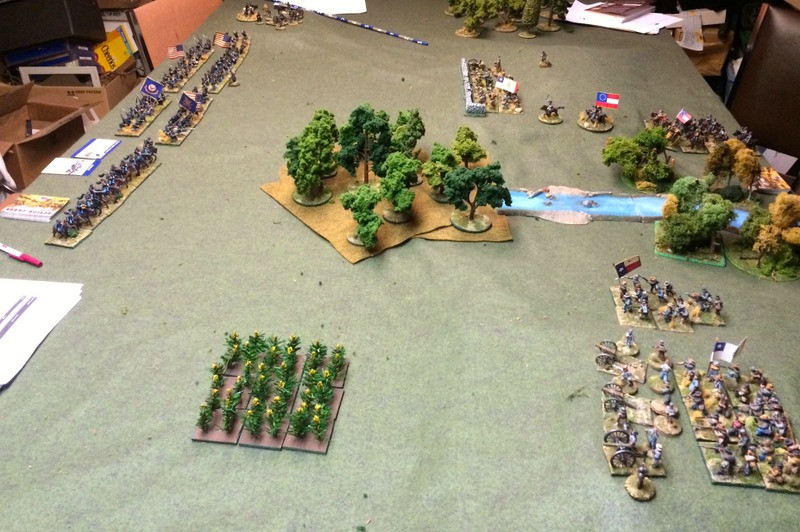
The 14th Mississippi and their supporting Napoleon watches the Yankee brigade massing in front of them. James leaves his cavalry to threaten my left flank, and he’s evidently determined to mass his force to take my right.
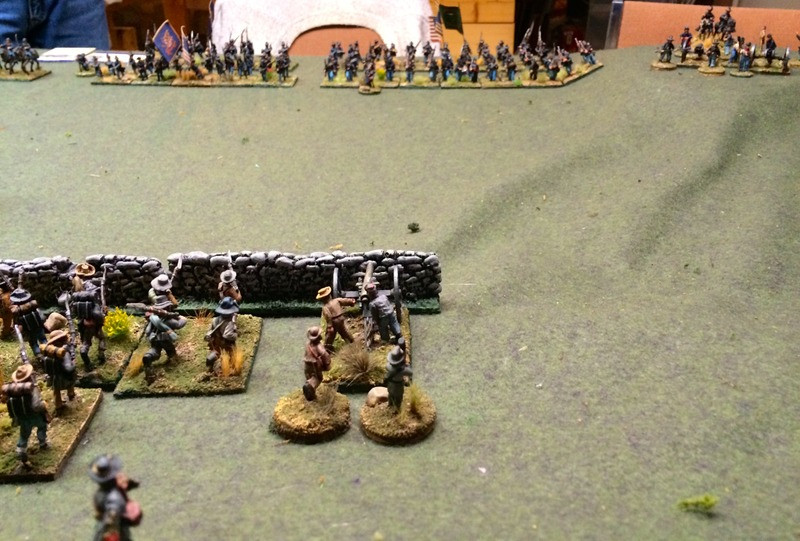
Trickiness! James acquired this card in the post-battle stage of our last game, and plays it on me know. I lose the top four cards from my action deck for all of this game, reducing my deck and potentially depriving me of some nasty tricks of my own.

I immediately start to move my Texans to the ford to bolster the right flank, and have one my light guns on the left hill limber up to follow. James plays a card which has the effect of halting the Texans for a turn, which was quite clever as it blocked up the ford and delayed the transfer of my artillery as well.
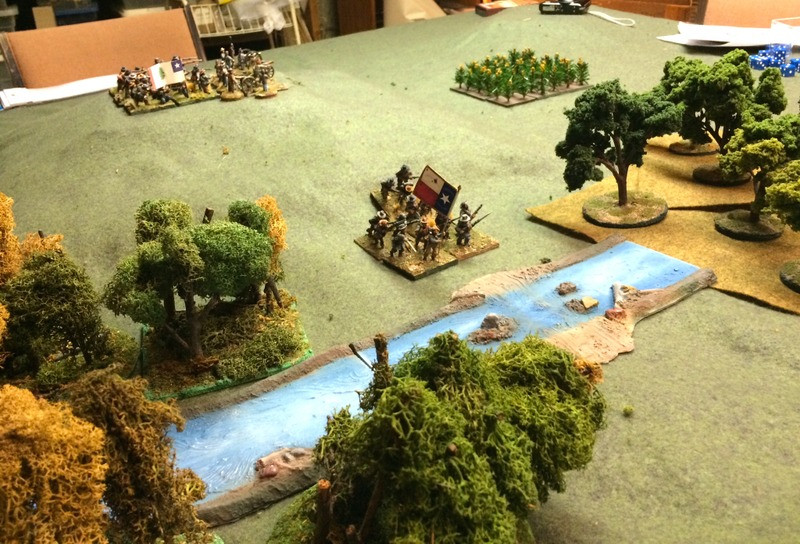
Fortunately the Kentucky cavalry aren’t likewise delayed, and they gallop behind the hill to take up position on the right of my line. They will prove useful in the fight to come.

Artillery plays its part. My Napoleon crew pours canister fire into the advancing bluecoats, while James bombards the Mississipians behind their stone well. The cover advantage helps them enormously (James could only hit the on a 6 on a d6) and while they would lose two stands, the Mississippians hold firm.
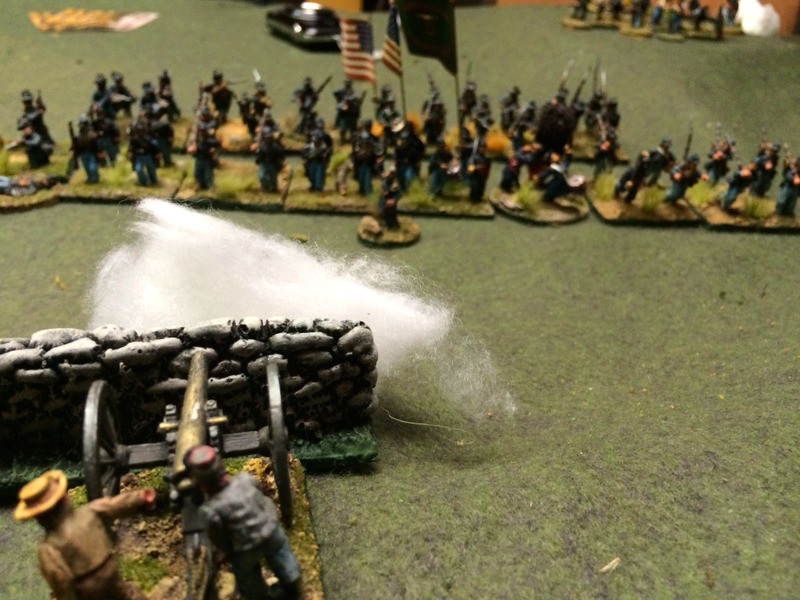
Cannister fire from the Napoleon tears gaps in the Irish line, but they still advance.

The reinforcement of my Texans on the right was further delayed when James played a Confusion card on them and they got mired in the swamp between the two hills. My light artillery section did arrive and took up position on the left of the 14th MS, and frantically began to unlimber. Meanwhile the 9th KY formed line and dismounted. I had considered leaving them mounted, until realizing that Longstreet penalizes mounted cavalry in melee with formed infantry facing to their front, on the grounds that such engagements were rare in the ACW and usually ended badly for the cavalry. Better to have the KY boys in a firing line, I thought, and their weight of fire would prove valuable.

James had a very sound plan of attack, which was to assault my position with as much strength as he could muster. Alas for him, I played the Pinkerton Intelligence card, which invokes hesitation and prevents one unit from charging or attacking in a given turn. I don’t think I get to play that card in scenarios after 1862, but it is helpful until then, and this meant that half of James’ brigade did not charge. He had some success, capturing my light artillery before it could unlimber, but the 14th MS held firm and threw the Yanks back from the wall in confusion.
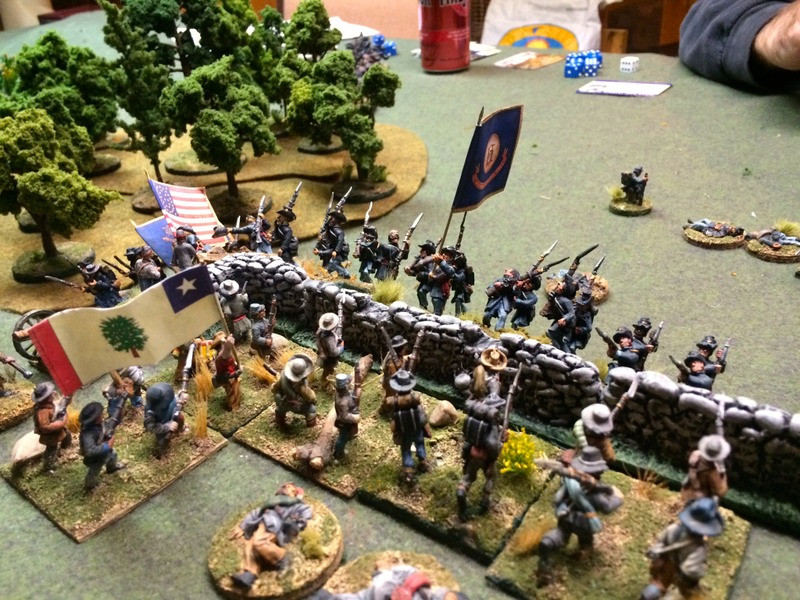
My boys pour it into the Yanks while the Texans finally emerge from the swamp and threaten the Yanks’ flanks.
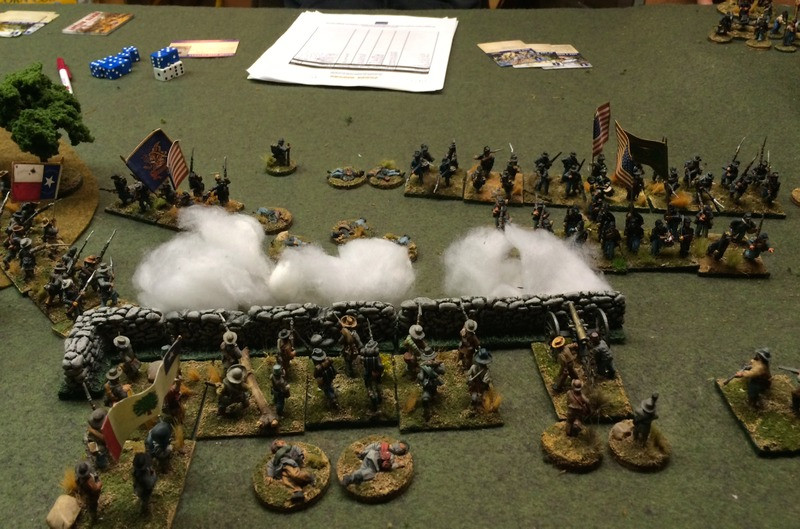
In a scene very reminiscent of Fredericksburg, the Yanks fall back from the deadly wall, leaving the field strewn with their dead and wounded. James has had two of his four infantry regiments wrecked, and lost his chance to storm the objective. He preserves his force for another day.
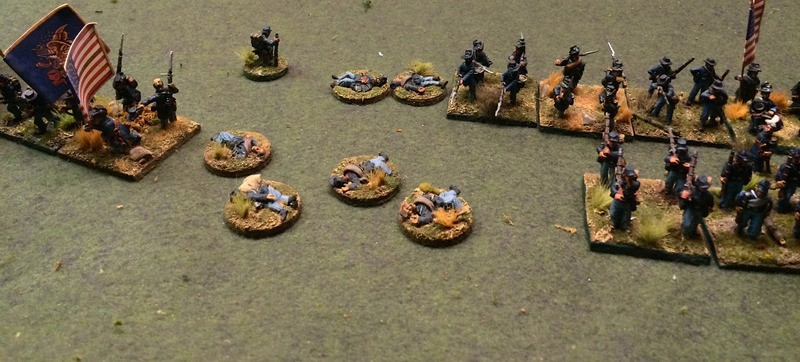
In the post-battle phase, I get my second victory of the campaign, (2 for 2) but neither James or I get promoted (nothing really but a Longstreet mechanism for bragging rights). He picked up an Epic Point for capturing my gun, but I got two Eps for holding both the objectives. In the after battle reckoning, none of my regiments lost any Elan for tacking casualties, so all four are still rated as Eager. However, sadly, both my Eager Veteran infantry, both untouched during the battle, lost two stands each from disease. Poor camp discipline, I fear. On the positive side, I was able to raise the 14th MS to Veteran status and did receive a second Napleon to bring my artillery to four bases. I also received two green units to bring me up to full strength for a CSA brigade in 1862 (less than the Union max strength).
Glossop’s Brigade now consists of:
Infantry: 21st Miss (Eager Veteran) 4 stands, 9th Texas (Eager Veteran) 4 stands, 14th Mississippi (Eager Veteran) 5 stands, 31 Tennessee (Eager Recruit) 7 stands, 25th Mississippi (Eager Recruit) 7 stands.
Cavalry: 9th Kentuck (Eager Recruit) 5 stands.
Artillery: 1 6pr smoothbore, 1 6pd Howitzer, 2 Napoleon smoothbores.
Our impressions of Longstreet continue to be positive. We like the card system as a way of simulating friction and command and control, and enjoy the fun of putting a stick in the other’s spokes at a key moment in the fight. We also like the way Longstreet plays to a fairly quick conclusion once we have the basics mastered. The campaign game calls for two battles in 1862, so we look forward to another 1862 punch up with our regrouped and reinforced commands.
Blessings to your die rolls,
MP+

Lovely collection Michael. Longstreet seems a fun and exciting game to play with it's added card system.
ReplyDeleteHi Robert:
DeleteThanks, that collection has been growing for decades. Some of my old Minifigs ACW figures were acquired in the 1980s! Longstreet is far and away the most enjoyable and most playable ACW rules set I've come across.
What a great game. I always cheer the Irish on in any ACW game and they gave it their best shot here.
ReplyDeleteThanks sir. The Irish tried their best. They will be back, and as they are still rated as Eager, they will be tough boyos in the barney, to be sure. (I'm not sure if that means anything, but it sounds good. I used to reenact with Yanks pretending to be "Oirish jest off the boat" and bejabbers, the horrible accents - och mavone!.
DeleteVery nice figures there Mike. I'd imagine most of those are Old Glory?
ReplyDeleteThere does appear to be a worrying large amount of Rebel victory going around...
Hello CK:
DeleteMany of those chaps are Old Glory, but interspersed with Renegade, Redoubt, Foundry, a few Dixon and some Minifigs. I am most promiscuous in my acquisitions.
I have some Forgotten and Glorious Iron Brigade figures to paint this summer and they are mouth waveringly good.
Yes, lots of Rebel victory, but the Union, like the British, lose every battle but the one that really counts.
6 pounders in ACW? Are they scraping the bottom of the barrel?
ReplyDeleteGood report and great photos.
Well, they are early war guns. The big guns and rifled cannon start arriving in the post-battle cards by 1862.
DeleteMike
ReplyDeleteGreat looking game. I would be sorely tempted but already have too many distractions!
Cheers, PD
Thank you, Peter. "Lead us not into temptation, for we can find it for ourselves".
DeleteNice report, a fantastic collection and splendid photos!
ReplyDeleteCheers, Phil. Glad you liked it.
DeleteBoth battle and troops look terrific. Pleased to see your forces prevailed despite losing an unlimbered gun to attack and James' play of the "Sabotage" card.
ReplyDeleteLongstreet seems to add a lot of uncertainly and friction into a game. Too much or just the right amount added?
Some Union general, John Gibbon perhaps, once said that "Guns were made to be taken". He felt artillery was expendable in the great scheme of things.
DeleteGood question. I think Mustafa gets it right in Longstreet. There is a lot of friction in the cards but if you read accounts of the battles, it is always maddening, I think, how near to victory they always seemed to come and yet it often eludes them. So I think the cards serve their purpose and make for some good moments of hilarity and gaming pleasure as well.
Looks like a fantastic game padre!
ReplyDeleteThe more I read your AAR's on Longstreet, the more I am feeling inclined to start setting aside the $$$ to pick up a set of the rules and cards.
ReplyDeleteGlad the Reb's once again won the day!
Nice game- I should really move the ACw up my list of priorities.
ReplyDeleteCheers,
Pete.
Thanks, chaps. You can't beat the Civil War for colour and excitement, I don't think. If I had to choose between Napoleonics and ACW in 28mm, it would be ACW hands down, but perhaps that's because I'm a North American and not a European.
ReplyDelete